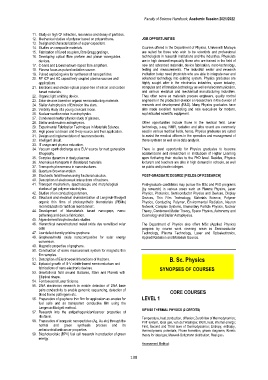Page 139 - Handbook Bachelor Degree of Science Academic Session 20212022
P. 139
Faculty of Science Handbook, Academic Session 2021/2022
11. Study on high Q refraction, resonance and decay of particles.
2
12. Mechanical studies of polymer based on polyurethane. JOB OPPORTUNITIES
13. Design and characterization of super-capacitors.
14. Studies on composite materials. Courses offered in the Department of Physics, Universiti Malaya
15. Fabrication of fused couplers, fibre Bragg gratings. are suited for those who wish to be scientists and professional
16. Developing optical fibre preform and planar waveguides technologists in research institutions and the industries. Physicists
devices. are in high demand especially those who are trained in the field of
17. C-band and L-band erbium-doped fibre amplifiers. new and advanced materials, device fabrication, nano-technology,
18. Plasma focus as pulsed radiation source. testing and measurements. The industrial sector and research
19. Pulsed exploding wire for syntheses of nanoparticles. institution today need physicists who are able to integrate new and
20. RF ICP and AC capacitively coupled plasma sources and advanced technology into existing system. Physics graduates are
applications. highly sought after in the electronics industries, space industry,
21. Electronic and electro-optical proper-ties of silicon and carbon computer and information technology as well as telecommunication,
based materials. and various electrical and mechanical manufacturing industries.
22. Organic light emitting device. They often serve as materials process engineers, quality control
23. Solar devices based on organic semiconducting materials. engineers in the production division or researchers in the division of
24. Stellar Astrophysics of Emission line stars. research and development (R&D). Many Physics graduates have
25. Visibility study of a young crescent moon. also made excellent marketing and sale executives for modern,
26. Nuclear reaction rates in astrophysics. sophisticated scientific equipment.
27. Condensed matter physics study of glasses.
28. Stellar and neutrino astrophysics. Other opportunities include those in the medical field. Laser
29. Experimental Fabrication Techniques in Materials Science. technology, x-ray, NMR, radiation and ultra sound are commonly
30. High power ion beam and X-ray source and their application. used in various medical fields, hence, Physics graduates are suited
31. Design and implementation of neuron networks. to assist the medical officers in the operation and management of
32. Intelligent circuit. these systems as well as in data analysis.
33. IT usage and physics education.
34. Vacuum spark discharge as a EUV source for next generation There is great opportunity for Physics graduates to become
lithography. academicians and researchers in Institutions of Higher Learning
35. Complex dynamics in dusty plasmas. upon furthering their studies to the PhD level. Besides, Physics
36. Anomalous transports in disordered materials. lecturers and teachers are also in high demand in schools, as well
37. Transports phenomena in nanostructures. as public and private colleges.
38. Quantum Brownian motion.
39. Stochastic field theories using fractional calculus. POST-GRADUATE DEGREE (FIELDS OF RESEARCH)
40. Description of electroweak interactions of hadrons.
41. Transport mechanism, spectroscopic and morphological Post-graduate candidates may pursue the MSc and PhD programs
studies of gel polymer electrolytes. (by research) in various areas such as Plasma Physics, Laser
42. Studies of ion conducting polymers. Physics, Photonics, Semiconductor Physics and Devices, Display
43. Structural and electrical characterization of Langmuir-Blodgett Devices, Thin Film Technology, Materials Science, Polymer
organic thin films of photosynthetic biomaterials (PBMs) Physics, Conducting Polymer, Environmental Radiation, Neuron
reconstituted into “artificial membranes”. Network, Complex Systems, Elementary Particle Physics, Nuclear
44. Development of biomaterials based nano-gaps, nano- Theory, Condensed Matter Theory, Space Physics, Astronomy and
patterning and device fabrication. Cosmology and Stellar Astrophysics.
45. Algae derived biophotovoltaic studies.
46. Hierarchical nanostructured metal oxide dye sensitized solar The Department of Physics also offers MSc (Applied Physics)
cells program by course work covering areas in Semiconductor
47. Low defect density pristine graphene Technology, Plasma Technology, Laser and Optoelectronics,
48. Graphene/metal oxide nanocomposites for solar energy Applied Radiation and Materials Science.
conversion.
49. Magnetic properties of graphene.
50. Construction of noise measurement system for magnetic thin
film samples.
51. Description of Electroweak Interactions of Hadrons. B. Sc. Physics
52. Epitaxial growth of III-V nitride-based semiconductors and
fabrications of nano-electronic devices. SYNOPSES OF COURSES
53. Gravitational field around Galaxies, Stars and Planets with
Elliptical shape.
54. Femtosecond Laser Science.
55. DNA electronics research to enable detection of DNA base
pairs conductivity to enable genomic sequencing, detection of CORE COURSES
blood borne pathogens etc.
56. Preparation of graphene thin film for application as anodes for LEVEL 1
fuel cells and as transparent conductive film using the
Langmuir-Blodgett method.
57. Research into the antipathogenic/anticancer properties of SIF1003 THERMAL PHYSICS (2 CREDITS)
riboflavin. Temperature, heat conduction, diffusion; Zeroth law of thermodynamics;
58. Preparation of inorganic nanoparticles (Ag, Au etc) through the PVT system, Ideal gas, van der Waal gas; Work, heat, internal energy;
normal and green synthesis process and its First, Second and Third laws of thermodynamics; Entropy, enthalpy,
antimicrobial/anticancer properties. thermodynamic potentials; Phase transition, phase diagrams; Kinetic
59. Biophotovoltaic (BPV) fuel cell research in production of green theory for ideal gas; Maxwell-Boltzmann distribution; Real gas。
energy.
Assessment Method:
138

